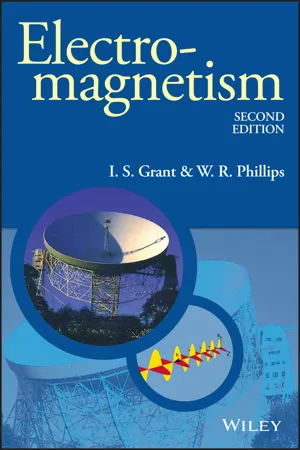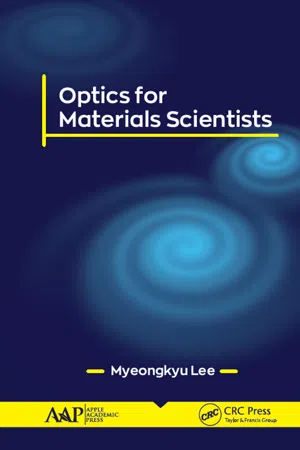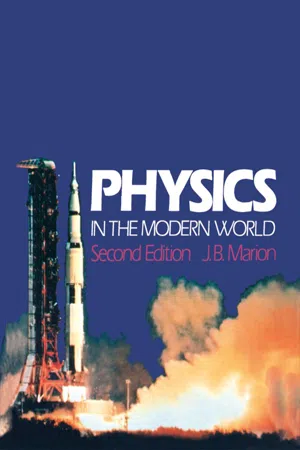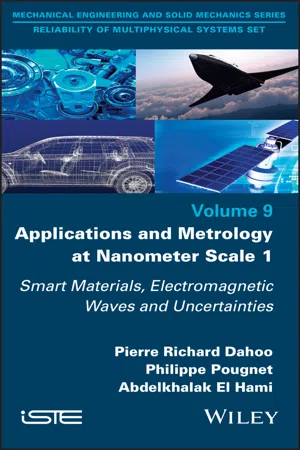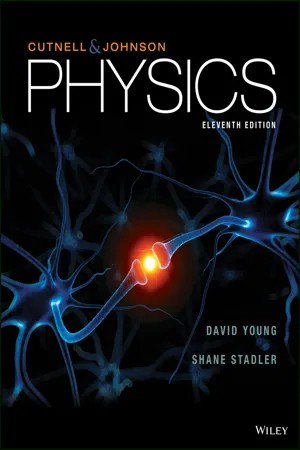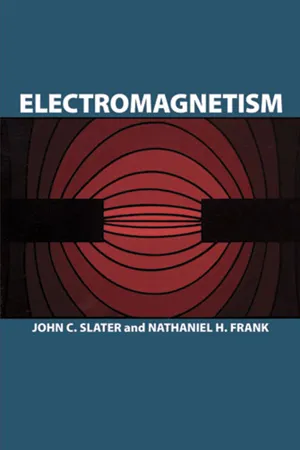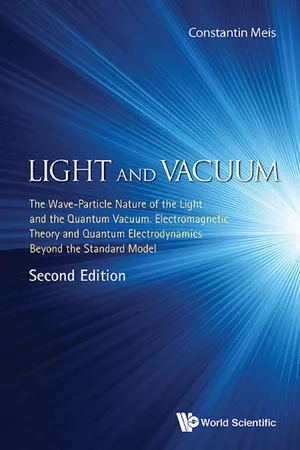Physics
The Transfer of Energy by Electromagnetic Waves
"The Transfer of Energy by Electromagnetic Waves" refers to the process by which energy is transmitted through space via electromagnetic waves, such as light, radio waves, and microwaves. These waves consist of oscillating electric and magnetic fields that carry energy from one place to another without the need for a medium. This transfer of energy plays a crucial role in various natural and technological processes.
Written by Perlego with AI-assistance
Related key terms
Related key terms
1 of 4
Related key terms
1 of 3
9 Key excerpts on "The Transfer of Energy by Electromagnetic Waves"
- Tamer Bécherrawy(Author)
- 2013(Publication Date)
- Wiley-ISTE(Publisher)
6.10. Electromagnetic spectrumAn electromagnetic wave carries energy; thus, it cannot be emitted by charges at rest or in uniform motion: only accelerated charges (or variable currents) may emit them. If the current is a simple harmonic function of time, the emitted wave is a simple harmonic of equal frequency. The emitter of a wavelength λ is always a system whose dimensions are comparable to λ. For instance, waves with wavelengths of roughly more than 1 mm are emitted by macroscopic systems (electronic or electric).While propagating, the electromagnetic waves experiences the various effects due to the propagation medium and eventual obstacles. The most important effects are the decrease of intensity with the increasing distance like 1/r 2 (in the case of isotropic emission), reflection on surfaces with large dimensions compared to the wavelength, diffraction by apertures and obstacles with dimensions comparable to λ , and absorption by the medium, etc.The most important applications of electromagnetic waves are in the domain of telecommunications. Information (sound, image, etc.) may be transmitted by modulated waves , that is, of amplitude, frequency or phase that vary according to the information. The modulation is realized using an input transducer , which transforms the information into an electric signal. Microphones and photoelectric cells are examples of input transducers. In the receiver, an output transducer transforms the electrical signal of the modulated wave into a non-electrical signal. A loudspeaker and a liquid crystal screen are examples of output transducers. The extracted signal reproduces the original signal with more or less deformations depending on the quality of the system.Here is a classification of electromagnetic waves according to their frequency (or their wavelength ) and some of their principal uses.1) Waves with industrial frequencies (30 Hz < < 3 kHz and 105 m < λ < 107 m): they are emitted by ac- eBook - ePub
- I. S. Grant, W. R. Phillips(Authors)
- 2013(Publication Date)
- Wiley(Publisher)
CHAPTER 11
Electromagnetic waves
We have already outlined in section 10.4 how a spark discharge can produce changing electric and magnetic fields that propagate outwards from the changing charge and current distributions in the spark. Any charge distribution which changes with time, or any varying current, can give rise to a radiated electromagnetic field. However it is only when the changes are rapid that the radiated fields are large enough to carry away an appreciable fraction of the power dissipated in the system. In practice radiated fields associated with varying currents are usually unimportant unless the variations contain frequencies higher than 100 kHz. This is about the lowest frequency used for commercial transmission of radio waves.In this chapter we will consider some general properties of electromagnetic waves propagating in free space or in homogeneous isotropic media. We will also consider what happens to simple waves at a plane boundary between two media. The electromagnetic field will be treated classically. This means that we will assume the energy in the waves to be distributed continuously throughout the space occupied by them, and the energy to depend in some way on the macroscopic fields E, D, B and H. The same approach was adopted in the discussion of the energies in static electric and magnetic fields. The media in which the waves are travelling will also be treated classically, as if they were continuous, and will be characterized by macroscopic quantities such as relative permittivity ε , relative permeability μ , and electrical conductivity σ . These quantities vary with frequency, although the electrical conductivity of almost all substances is effectively constant for most frequencies that we will consider. The interpretation of the parameters ε , μ and σ throws much light on the microscopic description of matter, but these problems will rarely be mentioned in this chapter. The classical theory provides a good description of most electromagnetic phenomena for frequencies below about 1011 - eBook - ePub
- Myeongkyu Lee(Author)
- 2019(Publication Date)
- Apple Academic Press(Publisher)
When Maxwell published his first extensive account of the electromagnetic theory in 1867, the frequency range was only known to extend from the IR, across the visible, to the UV. Although this range is of primary concern in optics, it is just a small segment of the whole electromagnetic spectrum. Ten years later, Hertz succeeded in producing and detecting electromagnetic waves. His transmitter was an oscillating discharge across a spark gap and he used an open loop of wire for a receiving antenna. A small spark induced between the two ends of the antenna indicated the detection of an incident electromagnetic wave. The waves used by Hertz are now classified in the radio frequency range, which extends from a few Hz to about 10 9 Hz (in wavelength, from several kilometers to 30 cm). These waves are usually generated by an assortment of electric circuits. FIGURE 1.14 The spectrum of electromagnetic radiation. The microwave region extends from about 10 9 Hz to 3 × 10 11 Hz and the corresponding wavelengths lies in between 0.3 m and 1 mm. Radiation that can penetrate the Earth’s atmosphere ranges from less than 1 cm to about 30 m. Microwaves are thus of interest in space-vehicle communications. Molecules can absorb and emit energy by altering the state of motion of their constituent atoms. They can be made to vibrate and rotate. The energy associated with each motion is quantized. Namely, molecules possess vibrational and rotational energy bands as well as their electronic energy bands. Only polar molecules experience forces via the electric field of an incident electromagnetic wave. The polar molecules can absorb a photon and make a rotational transition into an excited state. For instance, water molecules are polar. Thus, when exposed to an electromagnetic wave, they will swing around, trying to be lined up with the alternating electric field. This effect is particularly vigorous at any one of their rotational resonances (i.e., rotational energy bands) - eBook - ePub
- Jerry Marion(Author)
- 2012(Publication Date)
- Academic Press(Publisher)
transverse waves. (The electromagnetic field cannot support longitudinal waves.)A comparison of mechanical and electromagnetic waves is given in Table 14-1 .TABLE 14-1 COMPARISON OF MECHANICAL AND ELECTROMAGNETIC WAVESMECHANICAL WAVES ELECTROMAGNETIC WAVES Can be either transverse (for example, waves on a string) or longitudinal (for example, sound waves). Always transverse. Propagate by means of interactions among material particles. Can propagate through vacuum. Propagate with various speeds depending on the type of wave and the medium. Always propagate with the speed of light. (In different materials, the speed of light is less than the speed in vacuum, 3 × 108 m/s.) Characterized by the regular variation of a single quantity (for example, the density of air for sound waves or the amplitude of the vibrating particles for waves on a string). Characterized by the regular variation of two quantities, E and B . Carry energy and momentum. Carry energy and momentum. Receiving an Electromagnetic Signal
A radio transmitter impresses a signal on an electromagnetic wave by varying the frequency and the magnitude of the current flow in the antenna. The signal is then carried through space by the wave. How do we extract the signal from the wave at the receiving end? The procedure is essentially the reverse of that used at the transmitter. Figure 14-6 shows a receiving antenna which is identical to the transmitting antenna pictured in Fig. 14-2 - eBook - ePub
Applications and Metrology at Nanometer Scale 1
Smart Materials, Electromagnetic Waves and Uncertainties
- Pierre-Richard Dahoo, Philippe Pougnet, Abdelkhalak El Hami(Authors)
- 2021(Publication Date)
- Wiley-ISTE(Publisher)
hν), where ν is the frequency associated with the color of light. In the case of the photoelectric effect, induced absorption takes place. Modeling a black body as a source that radiates energy in discrete form, Planck solved the problem of the ultraviolet catastrophe of the black body emission. In 1915, Einstein explained the black body emission by introducing a symmetrical emission process in parallel with the absorption process that occurs in discrete form. Light can thus be considered as a wave or as a particle [BRO 68]. These approaches have been developed in specialized papers or books. The differences between classical sources (incoherent light) and quantum sources (coherent light) can be established from statistical theories of light. Notions of quantum mechanics are required to understand the particle nature of light in the form of photons [MES 64] [COH 73] such as the Glauber formulation, for example. To describe the state of wave polarization in a simplified form, a gauge is used to obtain the equation of the propagation of the electromagnetic wave in the transverse representation. This gauge choice makes it possible to express the electromagnetic field as a sum of independent oscillators (using creation and annihilation operators). This naturally leads to a quantum description of light in terms of photons, grains of light proposed by Einstein to interpret the photoelectric effect. It can be shown that energy is associated with a frequency and that light has a discrete character. Finally, Glauber’s approach connects the classical (continuous) and the quantum (discrete) descriptions and attributes a physical reality to coherent states with photons distributed according to a Poisson law.Nowadays, the wave–particle duality of light can be verified experimentally. The non-locality phenomenon was evidenced in the experiments conducted by Alain Aspect on quantum entanglement [ASP 82].This chapter is dedicated to various applications of electromagnetic waves. After having recalled the characteristics of these waves, applications are presented: the energy carried by a monochromatic plane wave, a rectangular waveguide, microwave antennas, the study of a wire antenna and antenna networks. These applications help understand the principles on which the fifth generation (5G) of mobile telecommunication systems are based.3.2. Characteristics of the energy carried by an electromagnetic wave
Electromagnetic waves carry energy. If is the electric field and is the magnetic field of the electromagnetic wave, the direction of the wave is the direction of the vector × .The Poynting vector is defined by:is expressed in joule per second per unit surface [(J/(s.m2 )].The norm of the Poynting vector represents the instantaneous power carried by the electromagnetic wave through the unit surface. The Poynting vector is perpendicular to the wave direction of propagation.The Poynting vector can also be written in the following integral form (though denoted by the same letter, the energy E and the electric field should not be confused):where is the unit vector perpendicular to dS .For a plane electromagnetic wave, the norm of the Poynting vector is:This quantity varies in time and space. In a given position, its average value is sin2 ( ) averaged over period T - eBook - ePub
- John D. Cutnell, Kenneth W. Johnson, David Young, Shane Stadler(Authors)
- 2018(Publication Date)
- Wiley(Publisher)
CHAPTER 24Electromagnetic WavesEach of the colors on the sails of these boats corresponds to a different wavelength in the visible region of the spectrum of electromagnetic waves. As we will see in this chapter, however, the visible wavelengths comprise only a small part of the total electromagnetic spectrum.LEARNING OBJECTIVES
After reading this module, you should be able to…- 24.1 Describe the nature of electromagnetic waves.
- 24.2 Calculate speed, frequency, and wavelength for electromagnetic waves.
- 24.3 Relate the speed of light to electromagnetic quantities.
- 24.4 Calculate energy, power, and intensity for electromagnetic waves.
- 24.5 Solve problems involving the Doppler effect for electromagnetic waves.
- 24.6 Solve polarization problems using Malus' law.
24.1 The Nature of Electromagnetic Waves
In Section 13.3 we saw that energy is transported to us from the sun via a class of waves known as electromagnetic waves. This class includes the familiar visible, ultraviolet, and infrared waves. In Sections 18.6 , 21.1 , and 21.2 we studied the concepts of electric and magnetic fields. It was the great Scottish physicist James Clerk Maxwell (1831–1879) who showed that these two fields fluctuating together can form a propagating electromagnetic wave . We will now bring together our knowledge of electric and magnetic fields in order to understand this important type of wave.Animated Figure 24.1 illustrates one way to create an electromagnetic wave. The setup consists of two straight metal wires that are connected to the terminals of an ac generator and serve as an antenna. The potential difference between the terminals changes sinusoidally with time t and has a period T. Part a shows the instantt = 0 s, when there is no charge at the ends of either wire. Since there is no charge, there is no electric field at the point P just to the right of the antenna. As time passes, the top wire becomes positively charged and the bottom wire negatively charged. One-quarter of a cycle later(, the charges have attained their maximum values, as part b of the drawing indicates. The corresponding electric fieldt =)1 4TE →at point P is represented by the red arrow and has increased to its maximum strength in the downward direction.* Part b - eBook - ePub
High-Intensity X-rays - Interaction with Matter
Processes in Plasmas, Clusters, Molecules and Solids
- Stefan P. Hau-Riege(Author)
- 2012(Publication Date)
- Wiley-VCH(Publisher)
Chapter 4 Electromagnetic Wave PropagationWhen an x-ray beam irradiates a material, the electric-field distribution and with that photon absorption are determined by wave propagation effects. The energy deposition profile, in turn, determines the nature of the x-ray–matter interaction process. In this chapter we review wave-propagation phenomena in continuous and structured materials, and specifically discuss applications to reflective multilayers and dispersive grazing incidence optics, which are of particular relevance for x-ray optics.4.1 Electromagnetic Waves in MatterThe behavior of electromagnetic fields in matter can be described using Maxwell equations (1.23) –(1.26) . For now, we will limit our discussion to infinitely extended (unbounded), homogeneous, isotropic media. We consider monochromatic plane harmonic waves, which are the simplest and most fundamental one-dimensional electromagnetic waves. They can be written as(4.1)(4.2)The actual physical electric and magnetic field are the real parts of E and H . At each instant in time, E and H are constant on planes defined by r · k = const . We can build arbitrary solutions to the Maxwell equation by linear superpositions of the plane waves (4.1) and (4.2) .We further assume that the medium is isotropic and linear so that it can be described by the permittivity ε (ω), the permeability μ(ω), and the conductivity σ(ω), so that(4.3)(4.4)(4.5)In the general dynamic case, ε0 (ω) is a complex quantity due to absorption losses in the material.The plane wave equations (4.1) and (4.2) have to fulfill Maxwell equations (1.23) to (1.26) . We assume ρ = 0, that is the medium is charge-neutral. Inserting (4.1) and (4.2) into (1.23) to (1.26) - eBook - ePub
- John C. Slater, Nathaniel H. Frank(Authors)
- 2012(Publication Date)
- Dover Publications(Publisher)
Maxwell and his immediate followers thought of the medium as resembling an elastic solid, the electrical energy representing the potential energy of strain of the medium, the magnetic energy the kinetic energy of motion. Though such a mechanical view is no longer held, still the energy is regarded as being localized in space, and as traveling in the manner indicated by Poynting’s vector. Thus, in a light wave, we shall show that there is a certain energy per unit volume, proportional to the square of the amplitude (E or H). This energy travels along, and Poynting’s vector is the vector that measures the rate of flow, or the intensity of the wave. We have already seen that E and H in a plane wave are at right angles to each other, and at right angles to the direction of flow; thus E × H must be along the direction of flow. In more complicated waves as well, Poynting’s vector points along the direction of the flow of radiation. If, for example, we have a source of light, and we wish to find at what rate it is emitting energy, we surround it by a closed surface, and integrate the normal component of Poynting’s vector over the surface. The whole conception of energy being transported in the medium is fundamental to the electromagnetic theory of light. When we come to charges and currents, however, it is a little harder to see the significance of the energy in the medium. For example, in a circuit consisting of a battery, and a wire connecting the plates, Poynting’s vector indicates that the energy flows out of the battery through the space surrounding the wire, and finally flows into the wire at the point where it will be transformed into heat. This seems to have small physical significance. With a moving charge, the situation is somewhat more reasonable. A simple model of an electron, which was supposed before the quantum theory to represent its actual structure, was a sphere of radius R, on the surface of which the charge is distributed - eBook - ePub
Light And Vacuum: The Wave-particle Nature Of The Light And The Quantum Vacuum. Electromagnetic Theory And Quantum Electrodynamics Beyond The Standard Model (Second Edition)
The Wave–Particle Nature of the Light and the Quantum Vacuum. Electromagnetic Theory and Quantum Electrodynamics Beyond the Standard Model
- Constantin Meis(Author)
- 2017(Publication Date)
- WSPC(Publisher)
lie in the plane that is transverse to the direction of propagation, with the same token Transverse Electric (TE) corresponding to the configuration with all the components of the electric field, but not those of the magnetic field, in the transverse plane to the propagation axis. Conversely, a Transverse Magnetic (TM) electromagnetic wave has all of the components of the magnetic field, but not those of the electric one, in the plane transverse to the propagation direction.•Energy flux of electromagnetic waves The vector product represents the instantaneous magnitude and direction of the power flow of the electromagnetic field and is called the Poynting vector.The power density (units: Watt m−2 ) along the propagation axis is obtained by time averaging the Poynting vector over a period TThe quantity is also called “Intensity” or “Irradiance” of the monochromatic electromagnetic wave.The energy density (units: Joules m−3 ) of a transverse monochromatic electromagnetic (TMEM) wave in vacuum oscillating at the angular frequency ω is obtained at the coordinate and at an instant t by the expression:where ε0 and µ0 are the vacuum permittivity and permeability related to the velocity of light in vacuum c by the simple relation:implying once again that the vacuum in classical electrodynamics has an electromagnetic essence.has to be understood as a time varying scalar field entailing that the energy density has not fixed values at any space coordinate, due naturally to the periodic variation of the electric and magnetic fields. Frequently, is expressed through the vacuum permittivity only, getting for the total energy of a monochromatic electromagnetic field in a volume V
Index pages curate the most relevant extracts from our library of academic textbooks. They’ve been created using an in-house natural language model (NLM), each adding context and meaning to key research topics.
Explore more topic indexes
Explore more topic indexes
1 of 6
Explore more topic indexes
1 of 4

